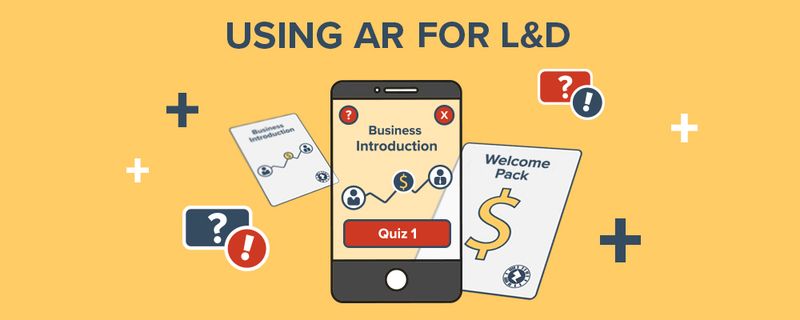Note: This article was updated on 10th June 2020.
Alongside other training methods, augmented reality (AR) is a new way to engage and train the workforce to reach new heights. At Zappar, we want to give the tools necessary to reap the huge benefits of immersive learning as a core part of the learning and development (L&D) program.
Over the last few decades, the corporate world has evolved to be more flexible with its approach to training its workforce. The one-size-fits-all approach is over; now, companies are using new and innovative approaches to train their workers in an easier, faster, and more impactful way. This article will explore how AR learning will help your employees thrive.
Want to learn more? Download our ebook to find out how Zapworks can help you build AR quickly and easily.
What is Learning and Development (L&D)?
(If you’re a L&D professional feel free to skip this bit)
Learning and Development (sometimes called Training and Development) teams are part of an organisation’s talent management strategy and aim to improve group and individual performance by providing them with the necessary skills and knowledge to be as successful and effective as possible. These teams look to align the goals and performance of employees with the organisation’s overall vision and goals.
Today’s job seekers (especially millennials and Gen Z) place great weight on finding a company that provides exceptional learning and development opportunities. This leads to Learning and Development (or L&D) also playing an important role in employee retention, ensuring that staff are provided with learning opportunities that will help them develop the skills required to grow into other roles within the organisation.
Executives are well aware of this and recognize that effective training can have a direct impact on their bottom line, and as a result are continually investing more money into L&D each year.
"...when learners are placed in an environment where they are “pulling” content through their own discovery versus being “pushed” content, that feeling of control can also result in much higher knowledge retention."
According to the ATD’s 2017 State of the Industry report, organizations spent $1,273 per employee on learning initiatives in 2016 (up from $1,252 in 2015). The report also states that the average number of formal learning hours per employee rose to 34.1 hours in 2016, up from 33.5 in 2015. In order for organizations to see a return on their investments in learning, L&D professionals must create high-quality training that effectively produces behavior change for their employees.
Likewise, for a behavior change to take place, learners must remain engaged throughout training. This is an ongoing challenge in L&D. Whether it be in a classroom or an eLearning course, with all of today’s distractions it is often difficult to grab and hold the attention of learners.
Another challenge can be providing learners with experiential learning opportunities, where they are actually able to interact or practice with whatever they are learning.
Augmented reality for Learning and Development
AR can be very effective in creating L&D solutions that truly immerse someone in whatever they are learning. Instead of being tied to a chair or desk, AR learning can help get learners moving around and actually interacting with the content. When learning is engaging and experiential like this, the knowledge retention of learners increases tremendously.
Furthermore, when learners are placed in an environment where they are “pulling” content through their own discovery versus being “pushed” content, that feeling of control can also result in much higher knowledge retention. Higher retention is crucial to achieving behavior changes that affect the bottom line, and ultimately produce the ROI that executives want to see.
AR learning is already quite prevalent in the healthcare, automotive and manufacturing industries. Rather than using traditional cadavers, medical students at Case Western Reserve University School of Medicine are using AR glasses to view a virtual human body in 3D, walk around it and navigate through layers of skin, muscle, and organs.
Check out Zappar’s ‘Secrets of the human body’ campaign with the BBC and The Open University
Unlike a cadaver, they can also see simulations of how an organ such as the heart actually functions and pumps blood, and view it from all different angles. Not only does this provide students with a whole new experience, but it also allows them to take their learning outside of the lab (and without taking a cadaver home!).
AR learning doesn’t need to be complicated to be effective
While creating something like virtual anatomical models would be complicated and require significant time, money and resources to develop, an authoring tool like Zapworks allows L&D professionals to quickly and easily create AR learning projects that are both effective for learners and cost-efficient.
"When learning is engaging and experiential like this, the knowledge retention of learners increases tremendously."
In a corporate environment, augmented reality can be used to create entirely new learning experiences, or simply supplement current training initiatives. Printed learning materials can be brought to life by taking something stationary and infusing it with animation and interactivity that engages the learner and demonstrates perspectives that simply can’t be shown with something static. Group activities can be transformed into interactive treasure hunts that get the learners up and moving and working together as they scan various items to solve clues and obtain new knowledge along the way.
Putting AR and Learning and Development into practice at DevLearn

This last October at DevLearn (North America’s largest learning technologies conference), my colleague, Destery Hildenbrand, and I had the opportunity to run a full day pre-conference workshop on getting started with augmented reality.
We had 25 learning professionals as participants, all of whom had either very little to no previous exposure to augmented reality and zero experience creating their own AR learning projects.
"For us, it was perfect validation of what we had been reiterating to them throughout the day: it doesn’t have to be expensive or complicated to be effective."
Icebreaker
We kicked off the workshop breaking the participants into six groups and sent each group to a different marker station throughout the classroom. The only instruction was to have one group member use a mobile device to scan an image on the wall at their station.
Scanning the image activated an AR experience that introduced either Destery or myself, and prompted them with three key activities— an interactive question, a discussion question to get to know their fellow group members, and then a riddle that sent them to the location of their next station.

The icebreaker experience we used at DevLearn.
They moved through six different stations learning various details about Destery and me, such as the companies we worked for, our roles, and the cities we lived in. Throughout their journey, they were also prompted with discussion questions that resulted in them learning those same details about each other. By the time they were finished they had learned a lot about their facilitators and peers, all while experiencing augmented reality firsthand.
Results of the icebreaker
We could not have been more pleased with how this icebreaker turned out – not only did it get everyone excited for the rest of the workshop, but it also led to some great discussions around how they could use similar style AR-enhanced treasure hunts within their own organizations for learning initiatives, such as new hire onboarding or group activities in instructor-led training.
Hands-on learning
The second part of the workshop was spent providing the participants with hands-on experience creating their own AR projects using Zapworks. We walked them through two step-by-step projects that allowed them to progressively learn how to use various features of the Zapworks authoring tool—first, a simple interactive business card and then secondly, a media-rich interactive poster.
With a solid baseline of skills established, we then assigned them with a group project in which they were to work in teams to develop an AR-enhanced onboarding program for new DevLearn Conference attendees. Each group was given about two hours to complete their project, with complete creative control over content and complexity. After time was up, we all took turns experiencing the projects that each group had created.
The results
The results were astonishing. Their final projects were incredibly creative, clever, and fun – all put together with a tool and technology that they hadn’t even touched prior to that morning! For us, it was the perfect validation of what we had been reiterating to them throughout the day: It doesn’t have to be expensive or complicated to be effective.
The future of augmented reality in Learning and Development
Some industries have been using AR for L&D for a number of years, but only within the last few years has it begun to garner mainstream attention. While there is a lot of buzz about the use of AR for learning, many professionals still believe it is very expensive and difficult to adopt.
As they begin to see there are authoring tools out there like Zapworks that make it very simple and affordable to work with AR, and as those tools become even easier to use, it’s likely that AR is going to become a prominent component of all L&D programs.
As well as app-based experiences, L&D professionals now have the advantage of using web-based experiences with their projects as well. WebAR allows mobile devices to access AR content online, without downloading an app. Find out more >>
A note on the author
Mark Banit is a Learning Solutions Architect specializing in creating powerful and engaging digital learning experiences. Mark is a regular speaker at various learning conferences throughout North America.
You can get in touch with Mark over at www.markbanit.com
 Mark Banit
Mark BanitL&D Professional, MarkBanit.com
